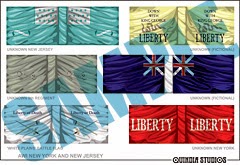
Very rarely do I write reviews. I don't consider myself an expert on the periods for which I paint little men, nor do I think others particularly care what I think. However, the American War of Independence is one of my periods of concentration and this book seemed worth the effort.
I just got my copy of
Rebellion! for Black Powder. The book was written by Stephen Jones and published, of course, by
Warlord Games. To be honest, the main reason I pre-ordered the book was to get the exclusive American officer sculpted by Alan Perry (I don't mind recycling drummers and standard bearers, but I am a sucker for distinctive officer models). I have never played Black Powder, but I enjoy the spirit in which the game is written and presented.
While I have not read the book cover to cover, simply flipping through revealed the extensive use it will see. First of all,
Rebellion! is crammed full of great color photos of Perry AWI models deployed on stunning terrain. I guess putting on the critic hat I would say that a few of the pics appear a bit fuzzy or out of focus and several more could have benefited from better lighting, but the majority are top quality. As someone who has published wargame books full of photos it is something to which I am sensitive, but none are so bad as to detract from the overall presentation. Most of the book is laid out in the standard two column format and is easy to read.
 |
| The Exclusive Mini |
Rebellion! features a thorough summary of the conflict across the different theaters of the war, but my favorite part is the army guides. These are worth the price of the book on their own. They cover the armies of Britain (including Hessians and American Loyalists), America (broken into four separate regions), France, and the Native American Indians. Each section covers organization, the various arms (infantry, cavalry, etc.), and uniforms of the forces. There are charts to cover specific units where such details were known. As I mentioned, I haven't read everything yet, but I see very little on the flags of the period. Highbrow AWI gamers will no doubt be annoyed to see the stars and stripes waving proudly over some of the American units...
There are also several pages on the weapons and tactics of the period and capsule biographies of the most prominent commanders on each side.
Finally we come to the scenarios. There are nineteen battles from Bunker Hill to Gloucester Point. The introduction to this section outlines the special rules needed to give Black Powder the proper feel for the period. Each scenario is presented with historical background, orders of battle, maps and terrain, deployment, and objectives. These are great scenarios for any rule system, not just Black Powder (and even make great set ups for fictional games in many horse and musket periods, not just the AWI).
Rebellion! provides inspiration to fuel collectors, painters, and wargamers. There is a wealth of information in the book, as well as a bibliography for more reading. You can also read Stephen Jones' designer notes
here.
In case you can't tell, I highly recommend this book to anyone with an interest in the American War of Independence. I'm off to pore over the uniform guides!




























